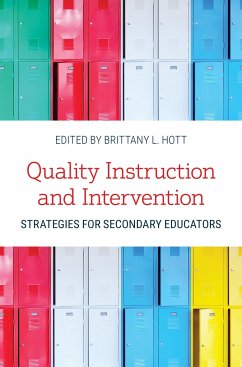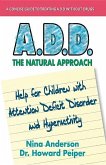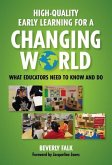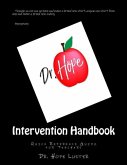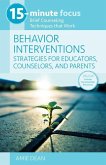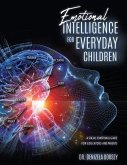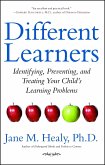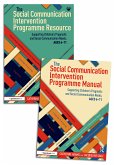Quality Instruction and Intervention Strategies for Secondary Educators
Herausgeber: Hott, Brittany L
Quality Instruction and Intervention Strategies for Secondary Educators
Herausgeber: Hott, Brittany L
- Broschiertes Buch
- Merkliste
- Auf die Merkliste
- Bewerten Bewerten
- Teilen
- Produkt teilen
- Produkterinnerung
- Produkterinnerung
This book equips educators with an introduction to quality general education instruction and the most up to date evidence-based academic and behavioral interventions, including instruction and intervention practices. Author teams of content area and strategy experts bridge the gap between effective instruction and quality intervention.
Andere Kunden interessierten sich auch für
![A.D.D. the Natural Approach A.D.D. the Natural Approach]() Nina AndersonA.D.D. the Natural Approach8,99 €
Nina AndersonA.D.D. the Natural Approach8,99 €![High-Quality Early Learning for a Changing World: What Educators Need to Know and Do High-Quality Early Learning for a Changing World: What Educators Need to Know and Do]() Beverly FalkHigh-Quality Early Learning for a Changing World: What Educators Need to Know and Do39,99 €
Beverly FalkHigh-Quality Early Learning for a Changing World: What Educators Need to Know and Do39,99 €![Intervention Handbook: Quick Reference Guide for Teachers Intervention Handbook: Quick Reference Guide for Teachers]() Hope C. LusterIntervention Handbook: Quick Reference Guide for Teachers23,99 €
Hope C. LusterIntervention Handbook: Quick Reference Guide for Teachers23,99 €![15-Minute Focus: Behavior Interventions: Strategies for Educators, Counselors, and Parents 15-Minute Focus: Behavior Interventions: Strategies for Educators, Counselors, and Parents]() Amie Dean15-Minute Focus: Behavior Interventions: Strategies for Educators, Counselors, and Parents15,99 €
Amie Dean15-Minute Focus: Behavior Interventions: Strategies for Educators, Counselors, and Parents15,99 €![Emotional Intelligence for Everyday Children: A Social-Emotional Guide for Educators and Parents Emotional Intelligence for Everyday Children: A Social-Emotional Guide for Educators and Parents]() Denizela DorseyEmotional Intelligence for Everyday Children: A Social-Emotional Guide for Educators and Parents35,99 €
Denizela DorseyEmotional Intelligence for Everyday Children: A Social-Emotional Guide for Educators and Parents35,99 €![Different Learners: Identifying, Preventing, and Treating Your Child's Learning Problems Different Learners: Identifying, Preventing, and Treating Your Child's Learning Problems]() Jane M. HealyDifferent Learners: Identifying, Preventing, and Treating Your Child's Learning Problems17,99 €
Jane M. HealyDifferent Learners: Identifying, Preventing, and Treating Your Child's Learning Problems17,99 €![The Social Communication Intervention Programme Manual and Resource The Social Communication Intervention Programme Manual and Resource]() Catherine AdamsThe Social Communication Intervention Programme Manual and Resource107,99 €
Catherine AdamsThe Social Communication Intervention Programme Manual and Resource107,99 €-
-
-
This book equips educators with an introduction to quality general education instruction and the most up to date evidence-based academic and behavioral interventions, including instruction and intervention practices. Author teams of content area and strategy experts bridge the gap between effective instruction and quality intervention.
Hinweis: Dieser Artikel kann nur an eine deutsche Lieferadresse ausgeliefert werden.
Hinweis: Dieser Artikel kann nur an eine deutsche Lieferadresse ausgeliefert werden.
Produktdetails
- Produktdetails
- Verlag: Rowman & Littlefield Publishers
- Seitenzahl: 294
- Erscheinungstermin: 17. März 2023
- Englisch
- Abmessung: 247mm x 181mm x 18mm
- Gewicht: 599g
- ISBN-13: 9781538143773
- ISBN-10: 1538143771
- Artikelnr.: 66872295
- Herstellerkennzeichnung
- Libri GmbH
- Europaallee 1
- 36244 Bad Hersfeld
- gpsr@libri.de
- Verlag: Rowman & Littlefield Publishers
- Seitenzahl: 294
- Erscheinungstermin: 17. März 2023
- Englisch
- Abmessung: 247mm x 181mm x 18mm
- Gewicht: 599g
- ISBN-13: 9781538143773
- ISBN-10: 1538143771
- Artikelnr.: 66872295
- Herstellerkennzeichnung
- Libri GmbH
- Europaallee 1
- 36244 Bad Hersfeld
- gpsr@libri.de
Contributors Julie Atwood, Brittany Batton, B. Keith Ben-Hanania Lenz, Glenna Billingsley, Brennan Chandler, Amber Curlee, Erica Fry, Dave Furjanic, Nicholas A. Gage, Ambra L. Green, Angela Green, Brittany L. Hott, Jasmine Justus-McDowell, Sami Khan, Tim Lintner, Ashley MacSuga-Gage, Darren Minarik, Jonté A. Myers, Jacquelyn Purser, Kathleen M. Randolph, John Romig, Jessica Singer Early, Tricia K. Strickland, Jonte C. Taylor, Jessica R. Toste, Kelly J. Williams, Pamela Williamson, Bradley S. Witzel About the Editor Brittany L. Hott, PhD, BCBA-D, is associate director of the Institute for Community and Society Transformation (ICAST) and associate professor of Special Education at the University of Oklahoma. She is a licensed behavior analyst and special education teacher with interests in rural school-based interventions and the effective translation of special education research to practice. Her publication record includes over sixty peer reviewed articles and program evaluations and over 100 national presentations. Her work is predominantly with rural deep east Texas and south east Oklahoma schools. Dr. Hott is a member of the executive board of the American Council on Rural Special Education and Past President of the International Council for Learning Disabilities.
Chapter 1: Introduction to Quality Instruction and Intervention
Brittany L. Hott and Angela Green
Chapter 2: High-Quality Core Classroom Reading Instruction
Pamela Williamson, Kelly J. Williams, Dave Furjanic, and Jessica R. Toste
Underlying Policies, Standards, Theories, and Research
* Educational Policy
* Academic Standards
* Foundational Theories
* Guiding Research
Reading Assessment and Instruction in Secondary English Language Arts
Classrooms
1. Assessments to Guide Instructional Planning and Decision-Making
2. Instructional Methods for Core Reading Instruction
* Effective and Explicit Instruction
* Vocabulary Instruction
* Comprehension Instruction
Resources
Conclusion
* Bridge from Instruction to Intervention
References
Chapter 3: Reading Intervention Methods for Secondary Students
Jessica R. Toste, Brennan Chandler, Erica Fry, and Kelly J. Williams
Theories Informing Reading Interventions for Secondary Students
Evidence Base on Reading Interventions
Assessment Methods to Guide Instructional Decision-Making
3. Data-Based Instruction
* Progress Monitoring
* Diagnostic Assessment
* Intervention Adjustments
Key Intervention Methods
4. Prerequisite Skills Instruction
5. Foundational Skills Routine
* Letter-Sound Review
* Blending Practice
* Read and Write Words
* New Concept
* Read Connected Text
6. Multisyllabic Word Reading Fluency
7. Multisyllabic Word Reading Instructional Routine
* Affix Learning
* Peel Off Reading.
* Word-Building Activity
* Word Reading Fluency
* Connected Text Reading
8. Fluency Building
* Oral Reading Fluency Routine
9. Content-Area Knowledge Building
* Vocabulary Routine
* Topic Introduction Routine
10. Building and Monitoring Reading Comprehension
11. Context Clues
12. Greek and Latin Roots
13. Question Types
14. Summarizing
* Get the Gist Routine
Conclusion
Intervention Resources
References
Chapter 4: Quality 6-12 Mathematics Instruction
Bradley S. Witzel, Tricia K. Strickland, and Jonté A. Myers
Chapter Objectives
Setting Goals in Secondary Mathematics
Planned Outcomes
Progressions across Grade and Content
Systematic Instruction
* Task Analysis Steps
* Task Analysis Example of Division of Fractions
* Task Analysis Example of Logs
Practice Standards
Practice and Homework
* Immediate Practice
* Completed with Potential Assistance
* Mixed Problems of Multiple Math Skills
* Completed in a Reasonable Amount of Time
Instructional Strategies
* Cognitive Strategies
* Visuals
Assessment to Drive Differentiation
* Differentiation
Conclusion
References
Chapter 5: Mathematics Interventions for Secondary Students with
Disabilities
Tricia K. Strickland, Bradley S. Witzel, and Jonté A. Myers
Characteristics of Students with Mathematics Learning Disabilities
Taxonomy of Intervention Intensity
Research-Based Instructional Practices
* Explicit Instruction
* Guided Practice Worksheet
* Quadratic Functions Cue Card
Multiple Representations
* Strategy Instruction
* Prompt Cards and Structured Worksheets
Linear, Quadratic, and Exponential Functions
* Linear Functions
* Quadratic Functions
* Exponential Functions
* Classwide Peer Tutoring (CWPT)
* Progress Monitoring
Conclusions
References
Chapter 6: Teaching the Podcast: Using a Genre Approach to Secondary
Writing Instruction
Amber Curlee and Jessica Singer Early
Objectives
Foundational Learning Theory
Guiding Research and Policy
Connection to Standards
Professional Groups
Formative/Summative Assessment Methods
Teaching the Podcast Genre
Assignment Examples
Mentor Texts
Writing Workshop Tip: Scriptwriting
* Finding Focus for Your Podcast
* Digital Tools
Celebrating Writing and Making It Public
Conclusion
Chapter 7: Writing Intervention
Ambra L. Green and John Romig
Formative Writing Assessments
* Curriculum-Based Measurement
* Exit Slips
* Error Analysis
* Holistic Ratings
* Generic Rubrics
* Genre-Specific Elements
Teaching Writing Strategies for the Writing Process
15. Theory Guiding Self-Regulated Strategy Development
16. Self-Regulated Strategy Development
17. Six Stages of Instruction
* Stage 1: Develop and Activate Background Knowledge
* Stage 2: Discuss It
* Stage 3: Model It
* Stage 4: Memorize It
* Stage 5: Support It
* Stage 6: Independent Performance
18. Writing Strategies
19. Self-Regulation Strategies
20. Case Study Example Using SRSD for the ACT Argumentative Essay
21. Paul's Independently Written Argumentative Essay
22. Writing to Learn
23. Technology Tools
24. Sentence Construction
Conclusion
References
Chapter 8: Science and Social Studies Content
Sami Khan, Tim Lintner, Darren Minarik, and Jonte C. Taylor
Why Science and Social Studies?
What Is Science?
25. Nature of Science (NOS)
26. Scientific Inquiry
27. Scientific Literacy
28. The Framework for K-12 Science Education and the Next Generation Science
Standards (NGSS)
29. Quality Assessment in Science Education
30. Some Key Instructional Methods in Science Education
31. Project-Based Learning (PBL)
32. Socioscientific Issues (SSI)
* Engineering Design Challenges
* Models and Simulations
What Is Social Studies?
33. Nature of Social Studies
34. Social Studies Inquiry
35. Social Studies Literacy
36. The College, Career, and Civic Life (C3) Framework for Social Studies State
Standards
37. Quality Assessment in Social Studies
38. Key Instructional Strategies in Social Studies Education
* Engagement
* Analysis
* Project-Based Learning
Applying Best Practices in Science and Social Studies through a Case Study
* Planning Instruction for All Students
* Science Assessments Explained
* Planning Instruction for All Students
* Social Studies Assessment Explained
Conclusion
References
Chapter 9: Science and Social Studies Intervention
Jonte C. Taylor, Darren Minarik, Sami Khan, and Tim Lintner
Evidence-Based and High Leverage Practices in Science and Social Studies
General Literacy and Content Acquisition Interventions for Science and
Social Studies
General Literacy Interventions in Science and Social Studies
39. Supported Inquiry
* Science-Based Inquiry Research
* Social Studies-Based Inquiry Research
40. Higher Order Thinking and Reasoning
41. Concept Comparison
42. Question Exploration
43. Cause and Effect
44. Decision-Making
45. Cross-Curricular Argumentation
46. Key Points
Content Acquisition Interventions in Science and Social Studies
47. Mnemonics
* Science-Based Mnemonics Research
* Social Studies-Based Mnemonics Research
48. Graphic Organizers
* Science-Based Graphic Organizer Research
* Social Studies-Based Graphic Organizer Research
49. Peer-Mediated Support Strategies
* Science-Based Peer-Mediated Strategies Research
* Social Studies-Based Peer-Mediated Strategies Research
50. Key Points
Conclusion
References
Chapter 10: Quality Behavior Instruction: Classroom Management
Ashley MacSuga-Gage, Jasmine Justus-McDowell, Nicholas A. Gage, and
Brittany Batton
Theoretical Foundations of Evidence-Based Classroom Management
Relevant Educational Policy Associated with Classroom Management
Classroom Management and Professional Standards of Educational Practice
Evidence-Based Classroom Management
51. Maximize Classroom Structure
* Description of the Skill
* Research Support
* How to Implement the Skill
52. Post, Teach, Review, Monitor, and Reinforce Positively Stated Rules and
Expectations
* Description of the Skill
* Research Support
* How to Implement the Skill
53. Actively Engage Students in Observable Ways
* Description of the Skill
* Research Support
* How to Implement the Skill
54. Establish a Continuum of Acknowledging Appropriate Behaviors
* Description of the Skill
* Research Support
* How to Implement the Skill
55. Establish a Continuum of Strategies to Respond to Inappropriate Behaviors
* Description of the Skill
* Research Support
* How to Implement the Skill
Conclusion
References
Chapter 11: Social, Emotional, and Behavioral Intervention
Kathleen M. Randolph, Glenna Billingsley, and Jasmine Justus-McDowell
Chapter Objectives
Operational Definitions of Behavior
Explicit Social Skills Instruction
Tier 2 Evidence-Based Interventions Classroom Management
56. Check-In/Check-Out
* Description of the Intervention
* Research Support
* How to Implement the Intervention
57. High Probability (High-P) Sequence
* Description of the Intervention
* Research Support
* How to Implement the Intervention
58. Self-Monitoring
* Description of the Intervention
* Research Support
* How to Implement the Intervention
59. Group Contingencies
* Description of the Intervention
* Research Support
* How to Implement the Intervention
Adding Intensive Interventions
60. Behavior Contracting
* Description of the Intervention
* Research Support
* How to Implement the Intervention
61. Daily Behavior Report Cards
* Description of the Intervention
* Research Support
* How to Implement the Intervention
62. FBA/BIP
* Description of the Intervention
* Research Support
* How to Implement the Intervention
Relevant Educational Policy
Foundational Learning Theory
Guiding Research
Professional Standards
Formative and Summative Assessment
Conclusion
References
Chapter 12: Good Study Strategies
B. Keith Ben-Hanania Lenz
What Should Be Studied?
Teaching Students with Poor Study Strategies
Features of Good Study Strategies
Approaches to Teaching Good Study Strategies
Good Ways to Study
63. Organizing Information to Structure Study
* Listening and Notetaking
64. Structuring Good Study
65. The Overall Study Plan
Progress Monitoring and Studying
Conclusion
Additional Resources
References
Chapter 13: Additional Resources
Julie Atwood, Jacquelyn Purser, and Brittany L. Hott
References
Index
About the Contributors
Brittany L. Hott and Angela Green
Chapter 2: High-Quality Core Classroom Reading Instruction
Pamela Williamson, Kelly J. Williams, Dave Furjanic, and Jessica R. Toste
Underlying Policies, Standards, Theories, and Research
* Educational Policy
* Academic Standards
* Foundational Theories
* Guiding Research
Reading Assessment and Instruction in Secondary English Language Arts
Classrooms
1. Assessments to Guide Instructional Planning and Decision-Making
2. Instructional Methods for Core Reading Instruction
* Effective and Explicit Instruction
* Vocabulary Instruction
* Comprehension Instruction
Resources
Conclusion
* Bridge from Instruction to Intervention
References
Chapter 3: Reading Intervention Methods for Secondary Students
Jessica R. Toste, Brennan Chandler, Erica Fry, and Kelly J. Williams
Theories Informing Reading Interventions for Secondary Students
Evidence Base on Reading Interventions
Assessment Methods to Guide Instructional Decision-Making
3. Data-Based Instruction
* Progress Monitoring
* Diagnostic Assessment
* Intervention Adjustments
Key Intervention Methods
4. Prerequisite Skills Instruction
5. Foundational Skills Routine
* Letter-Sound Review
* Blending Practice
* Read and Write Words
* New Concept
* Read Connected Text
6. Multisyllabic Word Reading Fluency
7. Multisyllabic Word Reading Instructional Routine
* Affix Learning
* Peel Off Reading.
* Word-Building Activity
* Word Reading Fluency
* Connected Text Reading
8. Fluency Building
* Oral Reading Fluency Routine
9. Content-Area Knowledge Building
* Vocabulary Routine
* Topic Introduction Routine
10. Building and Monitoring Reading Comprehension
11. Context Clues
12. Greek and Latin Roots
13. Question Types
14. Summarizing
* Get the Gist Routine
Conclusion
Intervention Resources
References
Chapter 4: Quality 6-12 Mathematics Instruction
Bradley S. Witzel, Tricia K. Strickland, and Jonté A. Myers
Chapter Objectives
Setting Goals in Secondary Mathematics
Planned Outcomes
Progressions across Grade and Content
Systematic Instruction
* Task Analysis Steps
* Task Analysis Example of Division of Fractions
* Task Analysis Example of Logs
Practice Standards
Practice and Homework
* Immediate Practice
* Completed with Potential Assistance
* Mixed Problems of Multiple Math Skills
* Completed in a Reasonable Amount of Time
Instructional Strategies
* Cognitive Strategies
* Visuals
Assessment to Drive Differentiation
* Differentiation
Conclusion
References
Chapter 5: Mathematics Interventions for Secondary Students with
Disabilities
Tricia K. Strickland, Bradley S. Witzel, and Jonté A. Myers
Characteristics of Students with Mathematics Learning Disabilities
Taxonomy of Intervention Intensity
Research-Based Instructional Practices
* Explicit Instruction
* Guided Practice Worksheet
* Quadratic Functions Cue Card
Multiple Representations
* Strategy Instruction
* Prompt Cards and Structured Worksheets
Linear, Quadratic, and Exponential Functions
* Linear Functions
* Quadratic Functions
* Exponential Functions
* Classwide Peer Tutoring (CWPT)
* Progress Monitoring
Conclusions
References
Chapter 6: Teaching the Podcast: Using a Genre Approach to Secondary
Writing Instruction
Amber Curlee and Jessica Singer Early
Objectives
Foundational Learning Theory
Guiding Research and Policy
Connection to Standards
Professional Groups
Formative/Summative Assessment Methods
Teaching the Podcast Genre
Assignment Examples
Mentor Texts
Writing Workshop Tip: Scriptwriting
* Finding Focus for Your Podcast
* Digital Tools
Celebrating Writing and Making It Public
Conclusion
Chapter 7: Writing Intervention
Ambra L. Green and John Romig
Formative Writing Assessments
* Curriculum-Based Measurement
* Exit Slips
* Error Analysis
* Holistic Ratings
* Generic Rubrics
* Genre-Specific Elements
Teaching Writing Strategies for the Writing Process
15. Theory Guiding Self-Regulated Strategy Development
16. Self-Regulated Strategy Development
17. Six Stages of Instruction
* Stage 1: Develop and Activate Background Knowledge
* Stage 2: Discuss It
* Stage 3: Model It
* Stage 4: Memorize It
* Stage 5: Support It
* Stage 6: Independent Performance
18. Writing Strategies
19. Self-Regulation Strategies
20. Case Study Example Using SRSD for the ACT Argumentative Essay
21. Paul's Independently Written Argumentative Essay
22. Writing to Learn
23. Technology Tools
24. Sentence Construction
Conclusion
References
Chapter 8: Science and Social Studies Content
Sami Khan, Tim Lintner, Darren Minarik, and Jonte C. Taylor
Why Science and Social Studies?
What Is Science?
25. Nature of Science (NOS)
26. Scientific Inquiry
27. Scientific Literacy
28. The Framework for K-12 Science Education and the Next Generation Science
Standards (NGSS)
29. Quality Assessment in Science Education
30. Some Key Instructional Methods in Science Education
31. Project-Based Learning (PBL)
32. Socioscientific Issues (SSI)
* Engineering Design Challenges
* Models and Simulations
What Is Social Studies?
33. Nature of Social Studies
34. Social Studies Inquiry
35. Social Studies Literacy
36. The College, Career, and Civic Life (C3) Framework for Social Studies State
Standards
37. Quality Assessment in Social Studies
38. Key Instructional Strategies in Social Studies Education
* Engagement
* Analysis
* Project-Based Learning
Applying Best Practices in Science and Social Studies through a Case Study
* Planning Instruction for All Students
* Science Assessments Explained
* Planning Instruction for All Students
* Social Studies Assessment Explained
Conclusion
References
Chapter 9: Science and Social Studies Intervention
Jonte C. Taylor, Darren Minarik, Sami Khan, and Tim Lintner
Evidence-Based and High Leverage Practices in Science and Social Studies
General Literacy and Content Acquisition Interventions for Science and
Social Studies
General Literacy Interventions in Science and Social Studies
39. Supported Inquiry
* Science-Based Inquiry Research
* Social Studies-Based Inquiry Research
40. Higher Order Thinking and Reasoning
41. Concept Comparison
42. Question Exploration
43. Cause and Effect
44. Decision-Making
45. Cross-Curricular Argumentation
46. Key Points
Content Acquisition Interventions in Science and Social Studies
47. Mnemonics
* Science-Based Mnemonics Research
* Social Studies-Based Mnemonics Research
48. Graphic Organizers
* Science-Based Graphic Organizer Research
* Social Studies-Based Graphic Organizer Research
49. Peer-Mediated Support Strategies
* Science-Based Peer-Mediated Strategies Research
* Social Studies-Based Peer-Mediated Strategies Research
50. Key Points
Conclusion
References
Chapter 10: Quality Behavior Instruction: Classroom Management
Ashley MacSuga-Gage, Jasmine Justus-McDowell, Nicholas A. Gage, and
Brittany Batton
Theoretical Foundations of Evidence-Based Classroom Management
Relevant Educational Policy Associated with Classroom Management
Classroom Management and Professional Standards of Educational Practice
Evidence-Based Classroom Management
51. Maximize Classroom Structure
* Description of the Skill
* Research Support
* How to Implement the Skill
52. Post, Teach, Review, Monitor, and Reinforce Positively Stated Rules and
Expectations
* Description of the Skill
* Research Support
* How to Implement the Skill
53. Actively Engage Students in Observable Ways
* Description of the Skill
* Research Support
* How to Implement the Skill
54. Establish a Continuum of Acknowledging Appropriate Behaviors
* Description of the Skill
* Research Support
* How to Implement the Skill
55. Establish a Continuum of Strategies to Respond to Inappropriate Behaviors
* Description of the Skill
* Research Support
* How to Implement the Skill
Conclusion
References
Chapter 11: Social, Emotional, and Behavioral Intervention
Kathleen M. Randolph, Glenna Billingsley, and Jasmine Justus-McDowell
Chapter Objectives
Operational Definitions of Behavior
Explicit Social Skills Instruction
Tier 2 Evidence-Based Interventions Classroom Management
56. Check-In/Check-Out
* Description of the Intervention
* Research Support
* How to Implement the Intervention
57. High Probability (High-P) Sequence
* Description of the Intervention
* Research Support
* How to Implement the Intervention
58. Self-Monitoring
* Description of the Intervention
* Research Support
* How to Implement the Intervention
59. Group Contingencies
* Description of the Intervention
* Research Support
* How to Implement the Intervention
Adding Intensive Interventions
60. Behavior Contracting
* Description of the Intervention
* Research Support
* How to Implement the Intervention
61. Daily Behavior Report Cards
* Description of the Intervention
* Research Support
* How to Implement the Intervention
62. FBA/BIP
* Description of the Intervention
* Research Support
* How to Implement the Intervention
Relevant Educational Policy
Foundational Learning Theory
Guiding Research
Professional Standards
Formative and Summative Assessment
Conclusion
References
Chapter 12: Good Study Strategies
B. Keith Ben-Hanania Lenz
What Should Be Studied?
Teaching Students with Poor Study Strategies
Features of Good Study Strategies
Approaches to Teaching Good Study Strategies
Good Ways to Study
63. Organizing Information to Structure Study
* Listening and Notetaking
64. Structuring Good Study
65. The Overall Study Plan
Progress Monitoring and Studying
Conclusion
Additional Resources
References
Chapter 13: Additional Resources
Julie Atwood, Jacquelyn Purser, and Brittany L. Hott
References
Index
About the Contributors
Chapter 1: Introduction to Quality Instruction and Intervention
Brittany L. Hott and Angela Green
Chapter 2: High-Quality Core Classroom Reading Instruction
Pamela Williamson, Kelly J. Williams, Dave Furjanic, and Jessica R. Toste
Underlying Policies, Standards, Theories, and Research
* Educational Policy
* Academic Standards
* Foundational Theories
* Guiding Research
Reading Assessment and Instruction in Secondary English Language Arts
Classrooms
1. Assessments to Guide Instructional Planning and Decision-Making
2. Instructional Methods for Core Reading Instruction
* Effective and Explicit Instruction
* Vocabulary Instruction
* Comprehension Instruction
Resources
Conclusion
* Bridge from Instruction to Intervention
References
Chapter 3: Reading Intervention Methods for Secondary Students
Jessica R. Toste, Brennan Chandler, Erica Fry, and Kelly J. Williams
Theories Informing Reading Interventions for Secondary Students
Evidence Base on Reading Interventions
Assessment Methods to Guide Instructional Decision-Making
3. Data-Based Instruction
* Progress Monitoring
* Diagnostic Assessment
* Intervention Adjustments
Key Intervention Methods
4. Prerequisite Skills Instruction
5. Foundational Skills Routine
* Letter-Sound Review
* Blending Practice
* Read and Write Words
* New Concept
* Read Connected Text
6. Multisyllabic Word Reading Fluency
7. Multisyllabic Word Reading Instructional Routine
* Affix Learning
* Peel Off Reading.
* Word-Building Activity
* Word Reading Fluency
* Connected Text Reading
8. Fluency Building
* Oral Reading Fluency Routine
9. Content-Area Knowledge Building
* Vocabulary Routine
* Topic Introduction Routine
10. Building and Monitoring Reading Comprehension
11. Context Clues
12. Greek and Latin Roots
13. Question Types
14. Summarizing
* Get the Gist Routine
Conclusion
Intervention Resources
References
Chapter 4: Quality 6-12 Mathematics Instruction
Bradley S. Witzel, Tricia K. Strickland, and Jonté A. Myers
Chapter Objectives
Setting Goals in Secondary Mathematics
Planned Outcomes
Progressions across Grade and Content
Systematic Instruction
* Task Analysis Steps
* Task Analysis Example of Division of Fractions
* Task Analysis Example of Logs
Practice Standards
Practice and Homework
* Immediate Practice
* Completed with Potential Assistance
* Mixed Problems of Multiple Math Skills
* Completed in a Reasonable Amount of Time
Instructional Strategies
* Cognitive Strategies
* Visuals
Assessment to Drive Differentiation
* Differentiation
Conclusion
References
Chapter 5: Mathematics Interventions for Secondary Students with
Disabilities
Tricia K. Strickland, Bradley S. Witzel, and Jonté A. Myers
Characteristics of Students with Mathematics Learning Disabilities
Taxonomy of Intervention Intensity
Research-Based Instructional Practices
* Explicit Instruction
* Guided Practice Worksheet
* Quadratic Functions Cue Card
Multiple Representations
* Strategy Instruction
* Prompt Cards and Structured Worksheets
Linear, Quadratic, and Exponential Functions
* Linear Functions
* Quadratic Functions
* Exponential Functions
* Classwide Peer Tutoring (CWPT)
* Progress Monitoring
Conclusions
References
Chapter 6: Teaching the Podcast: Using a Genre Approach to Secondary
Writing Instruction
Amber Curlee and Jessica Singer Early
Objectives
Foundational Learning Theory
Guiding Research and Policy
Connection to Standards
Professional Groups
Formative/Summative Assessment Methods
Teaching the Podcast Genre
Assignment Examples
Mentor Texts
Writing Workshop Tip: Scriptwriting
* Finding Focus for Your Podcast
* Digital Tools
Celebrating Writing and Making It Public
Conclusion
Chapter 7: Writing Intervention
Ambra L. Green and John Romig
Formative Writing Assessments
* Curriculum-Based Measurement
* Exit Slips
* Error Analysis
* Holistic Ratings
* Generic Rubrics
* Genre-Specific Elements
Teaching Writing Strategies for the Writing Process
15. Theory Guiding Self-Regulated Strategy Development
16. Self-Regulated Strategy Development
17. Six Stages of Instruction
* Stage 1: Develop and Activate Background Knowledge
* Stage 2: Discuss It
* Stage 3: Model It
* Stage 4: Memorize It
* Stage 5: Support It
* Stage 6: Independent Performance
18. Writing Strategies
19. Self-Regulation Strategies
20. Case Study Example Using SRSD for the ACT Argumentative Essay
21. Paul's Independently Written Argumentative Essay
22. Writing to Learn
23. Technology Tools
24. Sentence Construction
Conclusion
References
Chapter 8: Science and Social Studies Content
Sami Khan, Tim Lintner, Darren Minarik, and Jonte C. Taylor
Why Science and Social Studies?
What Is Science?
25. Nature of Science (NOS)
26. Scientific Inquiry
27. Scientific Literacy
28. The Framework for K-12 Science Education and the Next Generation Science
Standards (NGSS)
29. Quality Assessment in Science Education
30. Some Key Instructional Methods in Science Education
31. Project-Based Learning (PBL)
32. Socioscientific Issues (SSI)
* Engineering Design Challenges
* Models and Simulations
What Is Social Studies?
33. Nature of Social Studies
34. Social Studies Inquiry
35. Social Studies Literacy
36. The College, Career, and Civic Life (C3) Framework for Social Studies State
Standards
37. Quality Assessment in Social Studies
38. Key Instructional Strategies in Social Studies Education
* Engagement
* Analysis
* Project-Based Learning
Applying Best Practices in Science and Social Studies through a Case Study
* Planning Instruction for All Students
* Science Assessments Explained
* Planning Instruction for All Students
* Social Studies Assessment Explained
Conclusion
References
Chapter 9: Science and Social Studies Intervention
Jonte C. Taylor, Darren Minarik, Sami Khan, and Tim Lintner
Evidence-Based and High Leverage Practices in Science and Social Studies
General Literacy and Content Acquisition Interventions for Science and
Social Studies
General Literacy Interventions in Science and Social Studies
39. Supported Inquiry
* Science-Based Inquiry Research
* Social Studies-Based Inquiry Research
40. Higher Order Thinking and Reasoning
41. Concept Comparison
42. Question Exploration
43. Cause and Effect
44. Decision-Making
45. Cross-Curricular Argumentation
46. Key Points
Content Acquisition Interventions in Science and Social Studies
47. Mnemonics
* Science-Based Mnemonics Research
* Social Studies-Based Mnemonics Research
48. Graphic Organizers
* Science-Based Graphic Organizer Research
* Social Studies-Based Graphic Organizer Research
49. Peer-Mediated Support Strategies
* Science-Based Peer-Mediated Strategies Research
* Social Studies-Based Peer-Mediated Strategies Research
50. Key Points
Conclusion
References
Chapter 10: Quality Behavior Instruction: Classroom Management
Ashley MacSuga-Gage, Jasmine Justus-McDowell, Nicholas A. Gage, and
Brittany Batton
Theoretical Foundations of Evidence-Based Classroom Management
Relevant Educational Policy Associated with Classroom Management
Classroom Management and Professional Standards of Educational Practice
Evidence-Based Classroom Management
51. Maximize Classroom Structure
* Description of the Skill
* Research Support
* How to Implement the Skill
52. Post, Teach, Review, Monitor, and Reinforce Positively Stated Rules and
Expectations
* Description of the Skill
* Research Support
* How to Implement the Skill
53. Actively Engage Students in Observable Ways
* Description of the Skill
* Research Support
* How to Implement the Skill
54. Establish a Continuum of Acknowledging Appropriate Behaviors
* Description of the Skill
* Research Support
* How to Implement the Skill
55. Establish a Continuum of Strategies to Respond to Inappropriate Behaviors
* Description of the Skill
* Research Support
* How to Implement the Skill
Conclusion
References
Chapter 11: Social, Emotional, and Behavioral Intervention
Kathleen M. Randolph, Glenna Billingsley, and Jasmine Justus-McDowell
Chapter Objectives
Operational Definitions of Behavior
Explicit Social Skills Instruction
Tier 2 Evidence-Based Interventions Classroom Management
56. Check-In/Check-Out
* Description of the Intervention
* Research Support
* How to Implement the Intervention
57. High Probability (High-P) Sequence
* Description of the Intervention
* Research Support
* How to Implement the Intervention
58. Self-Monitoring
* Description of the Intervention
* Research Support
* How to Implement the Intervention
59. Group Contingencies
* Description of the Intervention
* Research Support
* How to Implement the Intervention
Adding Intensive Interventions
60. Behavior Contracting
* Description of the Intervention
* Research Support
* How to Implement the Intervention
61. Daily Behavior Report Cards
* Description of the Intervention
* Research Support
* How to Implement the Intervention
62. FBA/BIP
* Description of the Intervention
* Research Support
* How to Implement the Intervention
Relevant Educational Policy
Foundational Learning Theory
Guiding Research
Professional Standards
Formative and Summative Assessment
Conclusion
References
Chapter 12: Good Study Strategies
B. Keith Ben-Hanania Lenz
What Should Be Studied?
Teaching Students with Poor Study Strategies
Features of Good Study Strategies
Approaches to Teaching Good Study Strategies
Good Ways to Study
63. Organizing Information to Structure Study
* Listening and Notetaking
64. Structuring Good Study
65. The Overall Study Plan
Progress Monitoring and Studying
Conclusion
Additional Resources
References
Chapter 13: Additional Resources
Julie Atwood, Jacquelyn Purser, and Brittany L. Hott
References
Index
About the Contributors
Brittany L. Hott and Angela Green
Chapter 2: High-Quality Core Classroom Reading Instruction
Pamela Williamson, Kelly J. Williams, Dave Furjanic, and Jessica R. Toste
Underlying Policies, Standards, Theories, and Research
* Educational Policy
* Academic Standards
* Foundational Theories
* Guiding Research
Reading Assessment and Instruction in Secondary English Language Arts
Classrooms
1. Assessments to Guide Instructional Planning and Decision-Making
2. Instructional Methods for Core Reading Instruction
* Effective and Explicit Instruction
* Vocabulary Instruction
* Comprehension Instruction
Resources
Conclusion
* Bridge from Instruction to Intervention
References
Chapter 3: Reading Intervention Methods for Secondary Students
Jessica R. Toste, Brennan Chandler, Erica Fry, and Kelly J. Williams
Theories Informing Reading Interventions for Secondary Students
Evidence Base on Reading Interventions
Assessment Methods to Guide Instructional Decision-Making
3. Data-Based Instruction
* Progress Monitoring
* Diagnostic Assessment
* Intervention Adjustments
Key Intervention Methods
4. Prerequisite Skills Instruction
5. Foundational Skills Routine
* Letter-Sound Review
* Blending Practice
* Read and Write Words
* New Concept
* Read Connected Text
6. Multisyllabic Word Reading Fluency
7. Multisyllabic Word Reading Instructional Routine
* Affix Learning
* Peel Off Reading.
* Word-Building Activity
* Word Reading Fluency
* Connected Text Reading
8. Fluency Building
* Oral Reading Fluency Routine
9. Content-Area Knowledge Building
* Vocabulary Routine
* Topic Introduction Routine
10. Building and Monitoring Reading Comprehension
11. Context Clues
12. Greek and Latin Roots
13. Question Types
14. Summarizing
* Get the Gist Routine
Conclusion
Intervention Resources
References
Chapter 4: Quality 6-12 Mathematics Instruction
Bradley S. Witzel, Tricia K. Strickland, and Jonté A. Myers
Chapter Objectives
Setting Goals in Secondary Mathematics
Planned Outcomes
Progressions across Grade and Content
Systematic Instruction
* Task Analysis Steps
* Task Analysis Example of Division of Fractions
* Task Analysis Example of Logs
Practice Standards
Practice and Homework
* Immediate Practice
* Completed with Potential Assistance
* Mixed Problems of Multiple Math Skills
* Completed in a Reasonable Amount of Time
Instructional Strategies
* Cognitive Strategies
* Visuals
Assessment to Drive Differentiation
* Differentiation
Conclusion
References
Chapter 5: Mathematics Interventions for Secondary Students with
Disabilities
Tricia K. Strickland, Bradley S. Witzel, and Jonté A. Myers
Characteristics of Students with Mathematics Learning Disabilities
Taxonomy of Intervention Intensity
Research-Based Instructional Practices
* Explicit Instruction
* Guided Practice Worksheet
* Quadratic Functions Cue Card
Multiple Representations
* Strategy Instruction
* Prompt Cards and Structured Worksheets
Linear, Quadratic, and Exponential Functions
* Linear Functions
* Quadratic Functions
* Exponential Functions
* Classwide Peer Tutoring (CWPT)
* Progress Monitoring
Conclusions
References
Chapter 6: Teaching the Podcast: Using a Genre Approach to Secondary
Writing Instruction
Amber Curlee and Jessica Singer Early
Objectives
Foundational Learning Theory
Guiding Research and Policy
Connection to Standards
Professional Groups
Formative/Summative Assessment Methods
Teaching the Podcast Genre
Assignment Examples
Mentor Texts
Writing Workshop Tip: Scriptwriting
* Finding Focus for Your Podcast
* Digital Tools
Celebrating Writing and Making It Public
Conclusion
Chapter 7: Writing Intervention
Ambra L. Green and John Romig
Formative Writing Assessments
* Curriculum-Based Measurement
* Exit Slips
* Error Analysis
* Holistic Ratings
* Generic Rubrics
* Genre-Specific Elements
Teaching Writing Strategies for the Writing Process
15. Theory Guiding Self-Regulated Strategy Development
16. Self-Regulated Strategy Development
17. Six Stages of Instruction
* Stage 1: Develop and Activate Background Knowledge
* Stage 2: Discuss It
* Stage 3: Model It
* Stage 4: Memorize It
* Stage 5: Support It
* Stage 6: Independent Performance
18. Writing Strategies
19. Self-Regulation Strategies
20. Case Study Example Using SRSD for the ACT Argumentative Essay
21. Paul's Independently Written Argumentative Essay
22. Writing to Learn
23. Technology Tools
24. Sentence Construction
Conclusion
References
Chapter 8: Science and Social Studies Content
Sami Khan, Tim Lintner, Darren Minarik, and Jonte C. Taylor
Why Science and Social Studies?
What Is Science?
25. Nature of Science (NOS)
26. Scientific Inquiry
27. Scientific Literacy
28. The Framework for K-12 Science Education and the Next Generation Science
Standards (NGSS)
29. Quality Assessment in Science Education
30. Some Key Instructional Methods in Science Education
31. Project-Based Learning (PBL)
32. Socioscientific Issues (SSI)
* Engineering Design Challenges
* Models and Simulations
What Is Social Studies?
33. Nature of Social Studies
34. Social Studies Inquiry
35. Social Studies Literacy
36. The College, Career, and Civic Life (C3) Framework for Social Studies State
Standards
37. Quality Assessment in Social Studies
38. Key Instructional Strategies in Social Studies Education
* Engagement
* Analysis
* Project-Based Learning
Applying Best Practices in Science and Social Studies through a Case Study
* Planning Instruction for All Students
* Science Assessments Explained
* Planning Instruction for All Students
* Social Studies Assessment Explained
Conclusion
References
Chapter 9: Science and Social Studies Intervention
Jonte C. Taylor, Darren Minarik, Sami Khan, and Tim Lintner
Evidence-Based and High Leverage Practices in Science and Social Studies
General Literacy and Content Acquisition Interventions for Science and
Social Studies
General Literacy Interventions in Science and Social Studies
39. Supported Inquiry
* Science-Based Inquiry Research
* Social Studies-Based Inquiry Research
40. Higher Order Thinking and Reasoning
41. Concept Comparison
42. Question Exploration
43. Cause and Effect
44. Decision-Making
45. Cross-Curricular Argumentation
46. Key Points
Content Acquisition Interventions in Science and Social Studies
47. Mnemonics
* Science-Based Mnemonics Research
* Social Studies-Based Mnemonics Research
48. Graphic Organizers
* Science-Based Graphic Organizer Research
* Social Studies-Based Graphic Organizer Research
49. Peer-Mediated Support Strategies
* Science-Based Peer-Mediated Strategies Research
* Social Studies-Based Peer-Mediated Strategies Research
50. Key Points
Conclusion
References
Chapter 10: Quality Behavior Instruction: Classroom Management
Ashley MacSuga-Gage, Jasmine Justus-McDowell, Nicholas A. Gage, and
Brittany Batton
Theoretical Foundations of Evidence-Based Classroom Management
Relevant Educational Policy Associated with Classroom Management
Classroom Management and Professional Standards of Educational Practice
Evidence-Based Classroom Management
51. Maximize Classroom Structure
* Description of the Skill
* Research Support
* How to Implement the Skill
52. Post, Teach, Review, Monitor, and Reinforce Positively Stated Rules and
Expectations
* Description of the Skill
* Research Support
* How to Implement the Skill
53. Actively Engage Students in Observable Ways
* Description of the Skill
* Research Support
* How to Implement the Skill
54. Establish a Continuum of Acknowledging Appropriate Behaviors
* Description of the Skill
* Research Support
* How to Implement the Skill
55. Establish a Continuum of Strategies to Respond to Inappropriate Behaviors
* Description of the Skill
* Research Support
* How to Implement the Skill
Conclusion
References
Chapter 11: Social, Emotional, and Behavioral Intervention
Kathleen M. Randolph, Glenna Billingsley, and Jasmine Justus-McDowell
Chapter Objectives
Operational Definitions of Behavior
Explicit Social Skills Instruction
Tier 2 Evidence-Based Interventions Classroom Management
56. Check-In/Check-Out
* Description of the Intervention
* Research Support
* How to Implement the Intervention
57. High Probability (High-P) Sequence
* Description of the Intervention
* Research Support
* How to Implement the Intervention
58. Self-Monitoring
* Description of the Intervention
* Research Support
* How to Implement the Intervention
59. Group Contingencies
* Description of the Intervention
* Research Support
* How to Implement the Intervention
Adding Intensive Interventions
60. Behavior Contracting
* Description of the Intervention
* Research Support
* How to Implement the Intervention
61. Daily Behavior Report Cards
* Description of the Intervention
* Research Support
* How to Implement the Intervention
62. FBA/BIP
* Description of the Intervention
* Research Support
* How to Implement the Intervention
Relevant Educational Policy
Foundational Learning Theory
Guiding Research
Professional Standards
Formative and Summative Assessment
Conclusion
References
Chapter 12: Good Study Strategies
B. Keith Ben-Hanania Lenz
What Should Be Studied?
Teaching Students with Poor Study Strategies
Features of Good Study Strategies
Approaches to Teaching Good Study Strategies
Good Ways to Study
63. Organizing Information to Structure Study
* Listening and Notetaking
64. Structuring Good Study
65. The Overall Study Plan
Progress Monitoring and Studying
Conclusion
Additional Resources
References
Chapter 13: Additional Resources
Julie Atwood, Jacquelyn Purser, and Brittany L. Hott
References
Index
About the Contributors

